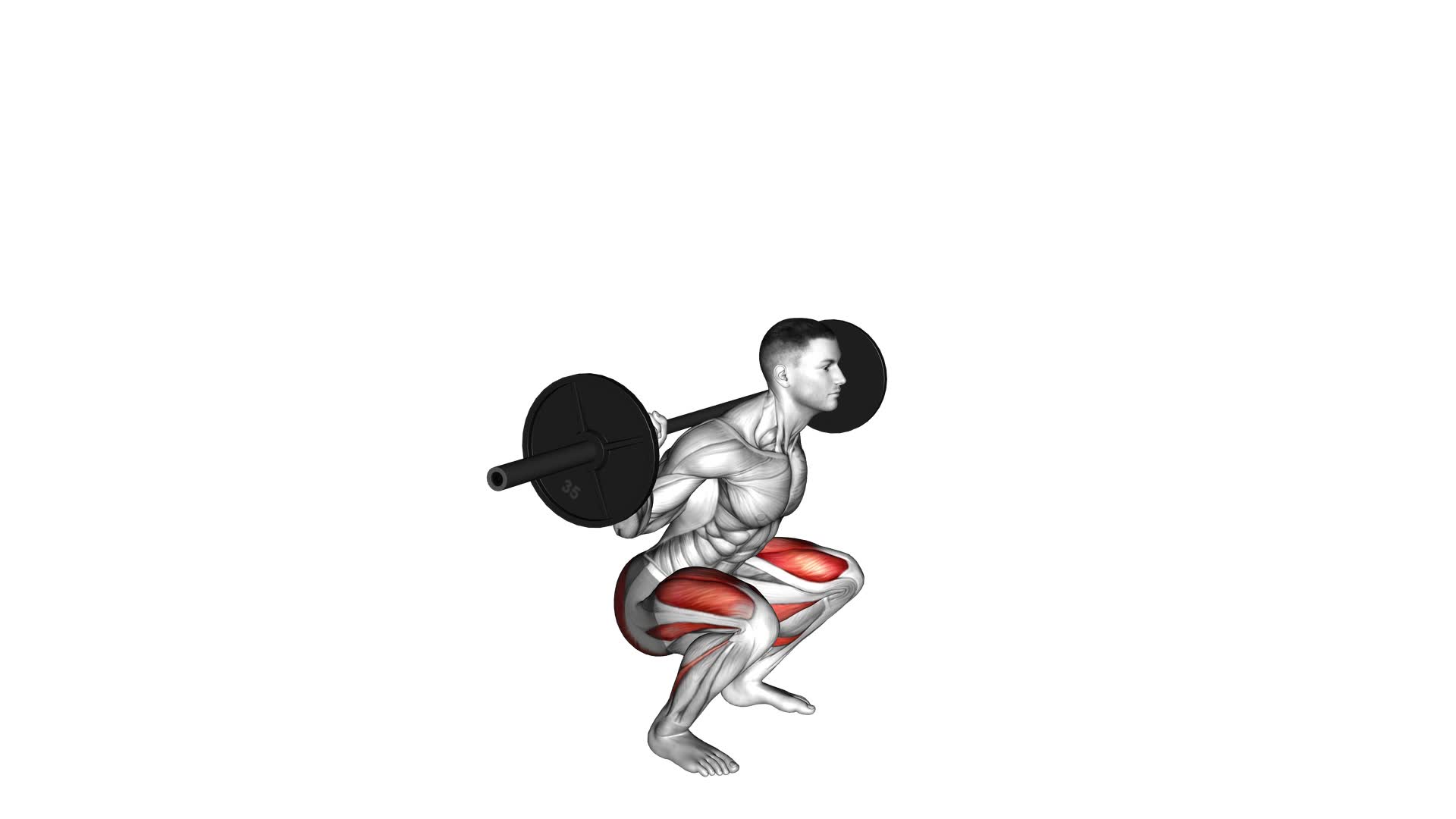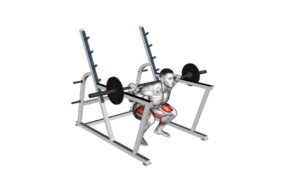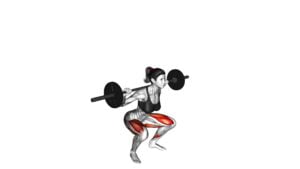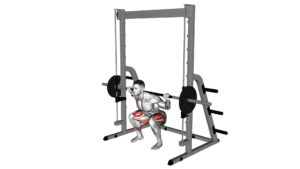Barbell Low Bar Squat – Video Exercise Guide & Tips

Are you looking to improve your squat technique and build lower body strength? Look no further than the Barbell Low Bar Squat.
Watch This Exercise Video
In this video exercise guide, we'll show you the proper set-up, grip, and technique to perform this highly effective exercise.
Avoid common mistakes, discover variations and progressions, and get tips for maximizing your squat performance.
Get ready to take your squat game to the next level with this comprehensive guide and video tutorial.
Key Takeaways
- The low bar squat engages multiple muscle groups simultaneously, leading to greater strength gains in targeted areas.
- Proper set-up and grip, including correct hand placement and stable shoulder positioning, are essential for performing the low bar squat correctly.
- Optimal bar positioning involves placing the barbell across the upper back and creating tension in the upper back for stability.
- Correct technique and form, such as maintaining good posture, pushing the hips back, and achieving proper squat depth, are important for performing the low bar squat effectively.
Benefits of the Low Bar Squat
To maximize your strength gains and target your posterior chain, the low bar squat is an excellent exercise to incorporate into your workout routine. This compound movement not only helps you build lower body strength but also offers numerous benefits for maximizing strength and preventing injuries.
One of the key advantages of the low bar squat is its ability to engage multiple muscle groups simultaneously. By placing the barbell lower on your back, you activate your glutes, hamstrings, and lower back to a greater extent compared to other squat variations. This increased muscle activation leads to greater strength gains in these areas, allowing you to lift heavier weights over time.
Furthermore, the low bar squat promotes better posture and spinal alignment. By keeping your torso more upright and your chest lifted during the movement, you develop a strong core and improved spinal stability. This not only helps prevent injuries but also enhances your overall lifting performance.
In addition, the low bar squat targets your posterior chain, which includes muscles like the glutes, hamstrings, and erector spinae. Strengthening these muscles is crucial for maintaining balance and stability, especially during activities that involve running, jumping, or lifting heavy objects.
Incorporating the low bar squat into your workout routine can help you maximize your strength gains, prevent injuries, and develop a strong posterior chain. Remember to maintain proper form and gradually increase the weight as you progress to ensure optimal results.
Proper Set-Up and Grip
To properly set up for the barbell low bar squat, you need to focus on three key points.
First, place your hands in the correct position on the bar, ensuring a secure grip.
Next, maintain stable shoulder positioning by retracting your scapulae and squeezing your upper back muscles.
Correct Hand Placement
Place your hands correctly on the barbell for a proper set-up and grip during the low bar squat. Improving your grip is essential to ensure stability and safety throughout the exercise. Avoid these hand placement mistakes to maximize your performance:
- Avoid gripping too wide: Placing your hands too wide on the bar can strain your shoulders and limit your range of motion. Keep your hands shoulder-width apart to maintain control.
- Don't grip too tightly: While a firm grip is necessary, squeezing the bar too tightly can lead to excessive tension and fatigue in your hands and wrists. Find a balance between a secure grip and relaxed hands.
- Avoid thumbs over the bar: Placing your thumbs over the bar can restrict your wrist mobility and decrease your ability to stabilize the weight. Instead, wrap your thumbs under the bar for better control and support.
Stable Shoulder Positioning
Ensure stability and maximize your performance by positioning your shoulders properly and gripping the barbell correctly.
Shoulder stability is crucial in maintaining proper squat mechanics and preventing injuries. To achieve stable shoulder positioning, start by placing the barbell across your upper back, resting it on the meaty part of your traps.
Your grip should be wide enough so that your wrists are in line with your elbows, forming a straight line. Squeeze your shoulder blades together and pull them down, creating tension in your upper back. This will help maintain a strong and stable position throughout the squat.
Optimal Bar Positioning
Position the barbell in the optimal low bar position on your upper back for proper set-up and grip. The correct barbell position is crucial for a successful low bar squat. Here are some key points to consider:
- Barbell Placement: Place the barbell across your upper back, just below the base of your neck. It should rest on the shelf created by your rear deltoids and upper trapezius muscles.
- Hand Grip: Grip the barbell with your hands slightly wider than shoulder-width apart. This grip will provide stability and control during the squat.
- Elbow Position: Keep your elbows pointing down and slightly back. This position will help maintain a tight upper back and prevent the barbell from rolling forward.
Proper barbell positioning is essential to maintain stability and balance throughout the squat. It allows for better transfer of force and increases squatting depth, ensuring maximum engagement of the leg muscles.
Correct Technique and Form
To perform the barbell low bar squat correctly, position yourself under the bar with your hands gripping it firmly and your feet shoulder-width apart. Make sure the bar is resting on the meaty part of your upper back, just below the base of your neck. This lower bar position is key for engaging your posterior chain and maximizing the benefits of the exercise.
As you descend into the squat, focus on keeping your chest up and your back straight. Maintain a slight arch in your lower back to ensure proper spinal alignment. Keep your knees in line with your toes and push your hips back as if you were sitting down on a chair. Go as low as you can while maintaining good form, aiming to get your hips below your knees.
When it comes to increasing weight, it's important to do so gradually. Adding too much weight too quickly can compromise your form and increase the risk of injury. Start with a weight that challenges you but still allows you to maintain proper technique. As you get stronger and more comfortable, gradually increase the weight in small increments.
Now that you know how to execute the barbell low bar squat correctly, let's discuss some common mistakes to avoid.
Common Mistakes to Avoid
To avoid compromising your form and risking injury, make sure you maintain proper technique while performing the barbell low bar squat. Here are some common mistakes to avoid, which will help you prevent injuries and improve your squat depth:
- Rounding your back: One of the most common mistakes is rounding your back during the squat. This puts unnecessary stress on your spine and can lead to injuries. Make sure to keep your back straight and engage your core muscles throughout the movement.
- Leaning too far forward: Leaning too far forward shifts the weight to your toes and puts excessive pressure on your knees. To maintain balance and proper form, focus on keeping your chest up and your weight evenly distributed throughout your feet.
- Not going low enough: Failing to reach the proper depth in your squat limits the effectiveness of the exercise. Aim to squat until your thighs are parallel to the ground or even slightly below. This will engage your muscles fully and promote strength and mobility.
Variations and Progressions
To continue building on your squat technique and challenging your strength, there are several variations and progressions you can incorporate into your barbell low bar squat routine. These advanced modifications and alternative exercises will help you target different muscles and add variety to your workouts.
One variation you can try is the front squat. Instead of placing the barbell on your back, you'll hold it in front of your body, resting it on your shoulders. This variation puts more emphasis on your quadriceps and core muscles, as well as improving your flexibility.
Another option is the box squat. This involves squatting down to a box or bench, rather than going all the way to the ground. By limiting your range of motion, you can focus on building strength in your glutes and hamstrings.
If you're looking for a challenge, you can try the Bulgarian split squat. This exercise involves placing one foot on a bench behind you and squatting down with the other leg. It targets your quadriceps, glutes, and hamstrings, while also improving your balance and stability.
Lastly, the goblet squat is a great alternative exercise that can be done with a dumbbell or kettlebell. Holding the weight close to your chest, you perform a squat, focusing on keeping your chest upright and engaging your core.
Incorporating these variations and progressions into your barbell low bar squat routine will help you continue to improve your strength and technique, while also preventing boredom and plateaus in your workouts.
Tips for Maximizing Your Squat Performance
To maximize your squat performance, it's crucial to focus on proper form techniques. This includes maintaining a neutral spine, engaging your core, and keeping your knees in line with your toes.
Additionally, gradually increasing the weight you squat can help build strength and improve your overall performance.
Proper Form Techniques
Maximize your squat performance with these 5 proper form techniques.
- Proper Breathing:
- Inhale deeply before descending into the squat and exhale forcefully as you push up. This helps stabilize your core and maintain proper form throughout the movement.
- Squat Depth:
- Aim to reach parallel or below with your thighs parallel to the ground. Going deeper engages more muscles and increases the effectiveness of the exercise.
- Tight Core:
- Brace your core by pulling your belly button towards your spine. This helps maintain stability and protects your lower back during the squat.
Proper form is crucial for maximizing your squat performance. By focusing on proper breathing, achieving the correct squat depth, and maintaining a tight core, you'll be able to perform squats with better control, stability, and efficiency.
Remember to practice these techniques consistently to improve your squat performance over time.
Increasing Squat Weight
If you want to increase the weight you can squat, follow these tips for maximizing your squat performance.
One of the key principles for increasing squat weight is progressive overload. This means gradually increasing the amount of weight you lift over time. Start by adding small increments of weight each week or every few sessions. This gradual increase will challenge your muscles and help them adapt to heavier loads.
Another important aspect is focusing on your squatting technique. Ensure that you have proper form and technique to maximize your strength and power. This includes maintaining a neutral spine, pushing through your heels, and engaging your core.
Frequently Asked Questions
What Are Some Common Cues or Mental Cues to Focus on While Performing the Low Bar Squat?
When performing the low bar squat, it's important to have mental focus and follow specific technique cues.
You need to concentrate on maintaining a tight core and bracing your abs. Keep your chest up and back straight while lowering your hips and bending your knees.
Push through your heels and drive the barbell up using your glutes and hamstrings. Remember to breathe and keep your balance throughout the movement.
Is It Necessary to Wear a Weightlifting Belt While Performing the Low Bar Squat?
When performing the low bar squat, you might be wondering if it's necessary to wear a weightlifting belt.
The use of a weightlifting belt during the low bar squat is a personal choice. Some lifters find that wearing a belt provides additional support and stability to the lower back, while others prefer to perform the exercise without one.
Ultimately, it depends on your comfort level and personal preferences. Experiment with and without a weightlifting belt to see what works best for you during the low bar squat.
Are There Any Specific Warm-Up Exercises or Stretches That Can Help Prepare for the Low Bar Squat?
Before beginning the low bar squat, it's important to properly warm up your muscles and stretch to prevent injury and improve performance.
Some effective warm-up exercises include bodyweight squats, lunges, and leg swings. These exercises help increase blood flow, loosen up your joints, and activate the muscles you'll be using during the squat.
Additionally, incorporating stretching techniques such as hip flexor stretches and hamstring stretches can help improve flexibility and range of motion for a better squatting experience.
Can the Low Bar Squat Help Improve Other Exercises or Athletic Performance?
The low bar squat can be a powerful exercise for improving your athletic performance. By targeting your lower body muscles, it helps to build strength and power, which can translate to improved performance in other exercises and sports.
Athletes can benefit from the low bar squat by increasing their explosive power, enhancing their speed and agility, and improving their overall athletic ability. Incorporating this exercise into your training routine can provide you with a competitive edge.
Are There Any Specific Breathing Techniques or Recommendations for Breathing During the Low Bar Squat?
When doing the low bar squat, it's important to focus on your breathing techniques. Take a deep breath before each rep and hold it until you reach the top of the movement. This will help stabilize your core and maintain proper form.
As you descend, exhale slowly and evenly. It's also helpful to use mental cues, like 'brace your core' or 'stay tight,' to remind yourself to engage the right muscles and maintain control throughout the exercise.
Conclusion
In conclusion, the barbell low bar squat is a highly effective exercise for building lower body strength and improving squat performance. By mastering the proper set-up, grip, and technique, you can maximize your results and avoid common mistakes.
Additionally, incorporating variations and progressions into your routine can help you continue challenging your muscles. Remember to always prioritize proper form and listen to your body to prevent injury.
Keep pushing yourself and enjoy the benefits of this powerful exercise.

Author
Years ago, the spark of my life’s passion ignited in my mind the moment I stepped into the local gym for the first time. The inaugural bead of perspiration, the initial endeavor, the very first surge of endorphins, and a sense of pride that washed over me post-workout marked the beginning of my deep-seated interest in strength sports, fitness, and sports nutrition. This very curiosity blossomed rapidly into a profound fascination, propelling me to earn a Master’s degree in Physical Education from the Academy of Physical Education in Krakow, followed by a Sports Manager diploma from the Jagiellonian University. My journey of growth led me to gain more specialized qualifications, such as being a certified personal trainer with a focus on sports dietetics, a lifeguard, and an instructor for wellness and corrective gymnastics. Theoretical knowledge paired seamlessly with practical experience, reinforcing my belief that the transformation of individuals under my guidance was also a reflection of my personal growth. This belief holds true even today. Each day, I strive to push the boundaries and explore new realms. These realms gently elevate me to greater heights. The unique combination of passion for my field and the continuous quest for growth fuels my drive to break new ground.







